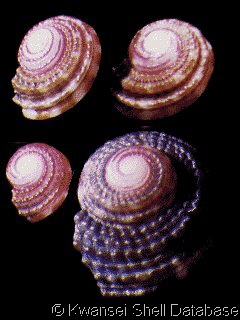Invasion History
First Non-native North American Tidal Record: 1964First Non-native West Coast Tidal Record: 1964
First Non-native East/Gulf Coast Tidal Record:
General Invasion History:
Clanculus ater is a top shell found in warm-temperate to tropical areas. It was described from Japan, and is known from scattered collections from southern Japan, India, and the Philippines (Pilsbry 1901; Museum of Comparative Zoology 2010; Academy of Natural Sciences of Philadelphia 2013). Ten specimens of this snail were found in Queen Charlotte Sound, British Columbia in 1964 (Clarke 1972; Carlton 1979; Carlton 1992). We know of no further introduced records of this gastropod.
North American Invasion History:
Invasion History on the West Coast:
Ten specimens of Clanculus ater were collected in August 1964 at the mouth of Codville Lagoon Marine Provincial Park, British Columbia, Canada (52°N) at low tide, on barnacle-encrusted rocks and shells, with typical cold-water native fauna (Clarke 1972). The vector of introduction is not clear. A ballast water introduction is possible from Japanese ships travelling through the Inside Passage. Oyster introductions are not known from the surrounding area around that time (Carlton 1979).
Description
Clanculus ater is a small, dextrally coiled top shell, with a wide conical shape, a low spire, and a nearly semicircular aperture. The shell is marked with spiral cords of rounded beads, which alternate between large and small beads. The sutures are deep. The adult shell has about 6 whorls and a deep umbilicus. The shell color is black, with a rose apex, and a few inconspicuous white dots. Adult shells range from about 7-12 mm in size (Pilsbry 1901).
Taxonomy
Taxonomic Tree
| Kingdom: | Animalia | |
| Phylum: | Mollusca | |
| Class: | Gastropoda | |
| Subclass: | Prosobranchia | |
| Order: | Archaeogastropoda | |
| Family: | Trochidae | |
| Genus: | Clanculus | |
| Species: | ater |
Synonyms
Clanculus ater (Pilsbry, 1901)
Potentially Misidentified Species
Ecology
General:
Snails of the family Trochidae (Top Shells) vary greatly in size, habitat, and geographical range. Specific information is not available for Clanculus ater, but in other species, such as Tegula funebralis (Black Turban Shell, NE Pacific native), and Trochus niloticus (Giant Top Shell, Indo-Pacific), sexes are separate. Both of these species have planktonic, but lecithotrophic, non-feeding veligers, with relatively short (4-21 days) planktonic periods (Moran 1997; Heslinga 1981). However, it is likely that modes of larval development vary throughout the family.
In British Columbia, C. ater was found grazing in a rocky-intertidal habitat, among barnacle-encrusted rocks, around which were found kelp and native amphipods, hermit crabs, starfish, and sea urchins (Clarke 1972; Carlton 1979). Other snails of this genus (e.g., C. puniceus, South Africa; C. guineensis, West Africa; C. cruciatus, southern Europe) are also known from rocky intertidal habitats. Clanculus ater's known native range (India and Philippines-southern Japan) makes establishmentl in Queen Charlotte Sound seem unlikely (Clarke 1972; Carlton 1979).
Food:
Algae
Trophic Status:
Herbivore
HerbHabitats
| General Habitat | Rocky | None |
| Salinity Range | Polyhaline | 18-30 PSU |
| Salinity Range | Euhaline | 30-40 PSU |
| Tidal Range | Low Intertidal | None |
| Vertical Habitat | Epibenthic | None |
Tolerances and Life History Parameters
| Broad Temperature Range | None | Warm temperate-Tropical |
| Broad Salinity Range | None | Polyhaline-Euhaline |
General Impacts
Outside its native Indo-Pacific range, the top shell Clanculus ater is known from only 10 specimens in Queen Charlotte Sound, British Columbia (Clarke 1972; Carlton 1979). This snail has no documented ecological or economic impacts.Regional Distribution Map
Non-native
Native
Cryptogenic
Failed
| Bioregion | Region Name | Year | Invasion Status | Population Status |
|---|---|---|---|---|
| NEP-III | Alaskan panhandle to N. of Puget Sound | 1964 | Non-native | Unknown |
| CIO-II | None | 0 | Native | Established |
| EAS-III | None | 0 | Native | Established |
| NWP-3a | None | 0 | Native | Established |
| NWP-3b | None | 0 | Native | Established |
| CIO-V | None | 0 | Native | Established |
Occurrence Map
| OCC_ID | Author | Year | Date | Locality | Status | Latitude | Longitude |
|---|
References
Academy of Natural Sciences of Philadelphia 2002-2024a Malacology Collection Search. <missing URL>Academy of Natural Sciences of Philadelphia 2006-2014b OBIS Indo-Pacific Molluscan Database. <missing URL>
Appeltans, W. et al. 2011-2015 World Registry of Marine Species. <missing URL>
Carlton, James T. (1979) History, biogeography, and ecology of the introduced marine and estuarine invertebrates of the Pacific Coast of North America., Ph.D. dissertation, University of California, Davis. Pp. 1-904
Carlton, James T. (1992) Introduced marine and estuarine mollusks of North America: An end-of-the-20th-century perspective., Journal of Shellfish Research 11(2): 489-505
Clarke, Arthur H. (1972) Clanculus microdon ater Pilsbry in British Columbia, Canadian Field-Naturalist 86: 165-166
Harvard Museum of Comparative Zoology 2008-2021 Museum of Comparative Zoology Collections database- Malacology Collection. <missing URL>
Heslinga, Gerald H. (1981) Larval development, settlement, and metamorphosis of the tropical gastropod Trochus niloticus, Malacologia 20(2): 349-357
Moran, A. L. (1997) Spawning and larval development of the black turban snail Tegula funebralis (Prosobranchia: Trochidae), Marine Biology 128: 107-114
Pilsbry, Henry A. (1901) New Mollusca from Japan, the Loo Choo Islands, Formosa and the Philippines., Proceedings of the Academy of Natural Sciences of Philadelphia 53(1): 193-210
